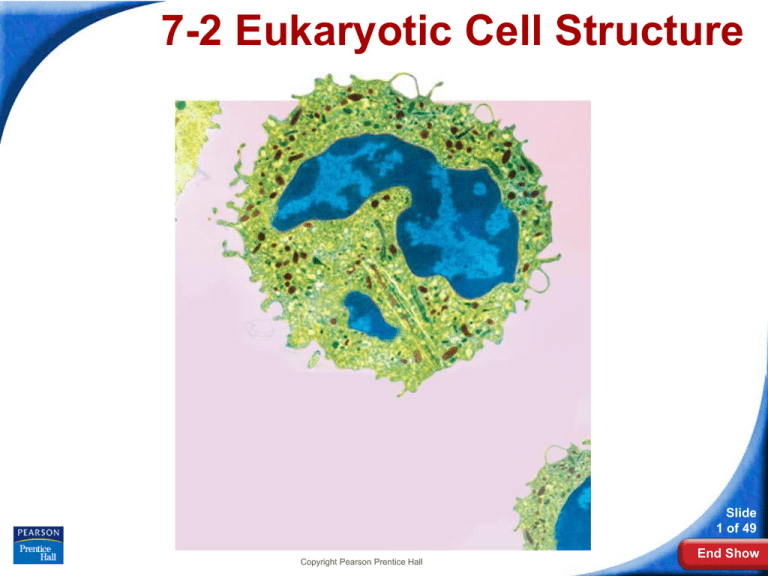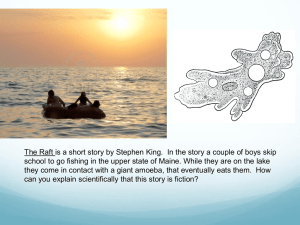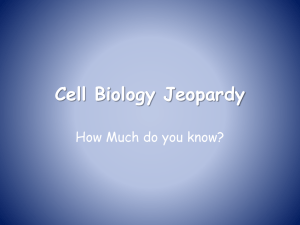
7-2 Eukaryotic Cell Structure
Slide
1 of 49
Copyright Pearson Prentice Hall
End Show
7-2 Eukaryotic Cell Structure
Eukaryotic Cell Structures
I. Eukaryotic Cell Structures
A. Cell Parts – 3 main parts:
1. Cell membrane - outside boundary.
Regulates what enters & leaves a cell.
2. Organelles - structures that perform
important cellular functions. Many
enclosed by membranes.
3. Cytoplasm – gel-like portion of the
cell that surrounds the organelles.
Slide
2 of 49
Copyright Pearson Prentice Hall
End Show
7-2 Eukaryotic Cell Structure
Eukaryotic Cell Structures
Animal Cell
Nucleolus
Smooth endoplasmic
reticulum
Nucleus
Ribosome (free)
Nuclear envelope
Cell membrane
Rough
endoplasmic
reticulum
Ribosome
(attached)
Centrioles
Golgi
apparatus
Mitochondrion
Slide
3 of 49
Copyright Pearson Prentice Hall
End Show
7-2 Eukaryotic Cell Structure
Eukaryotic Cell Structures
Plant Cell
Nucleolus
Nucleus
Smooth
endoplasmic
reticulum
Nuclear envelope
Ribosome (free)
Rough endoplasmic
reticulum
Ribosome
(attached)
Golgi
apparatus
Cell wall
Cell membrane
Chloroplast
Mitochondrion
Vacuole
Slide
4 of 49
Copyright Pearson Prentice Hall
End Show
7-2 Eukaryotic Cell Structure
Eukaryotic Cell Structures
II. Eukaryotic Organelles
A. Nucleus
1. Control center of the cell
2. Nuclear envelope
a. Double membrane around nucleus
3. Nuclear pores
a. Small channels that allow
substances to move in & out of
nucleus
4. Nucleolus
a. Where ribosomes are made
Copyright Pearson Prentice Hall
Slide
5 of 49
End Show
7-2 Eukaryotic Cell Structure
Nucleus
The Nucleus
Chromatin
Nuclear envelope
Nucleolus
Nuclear
pores
Slide
6 of 49
Copyright Pearson Prentice Hall
End Show
7-2 Eukaryotic Cell Structure
Eukaryotic Cell Structures
B. Ribosomes
1. Small particles composed of RNA &
protein
2. Found throughout the cytoplasm
3. Help to produce protein
Slide
7 of 49
Copyright Pearson Prentice Hall
End Show
7-2 Eukaryotic Cell Structure
Eukaryotic Cell Structures
C. Endoplasmic Reticulum (ER)
1. Extensive internal membrane system
2. Moves proteins and other substances
throughout the cell
3. Two types of ER:
a. Rough ER – has ribosomes
b. Smooth ER – no ribosomes
Slide
8 of 49
Copyright Pearson Prentice Hall
End Show
7-2 Eukaryotic Cell Structure
Eukaryotic Cell Structures
4. Rough ER
a. Protein made on ribosomes
b. Enters rough ER
c. Protein travels through ER
d. Portion of ER pinches off to form a
vesicle:
♣ Small membrane-bound sac that
transports substances
e. These proteins will usually be exported
from the cell
Slide
9 of 49
Copyright Pearson Prentice Hall
End Show
7-2 Eukaryotic Cell Structure
Endoplasmic Reticulum
Rough
Endoplasmic
Reticulum
Ribosomes
Slide
10 of 49
Copyright Pearson Prentice Hall
End Show
7-2 Eukaryotic Cell Structure
Eukaryotic Cell Structures
5. Smooth ER
a. Does not have ribosomes
b. Contains collections of enzymes that
perform specialized tasks such as:
♣ Synthesis of cell membrane lipids
♣ Detoxification of drugs
Slide
11 of 49
Copyright Pearson Prentice Hall
End Show
7-2 Eukaryotic Cell Structure
Endoplasmic Reticulum
Smooth
Endoplasmic
Reticulum
Slide
12 of 49
Copyright Pearson Prentice Hall
End Show
7-2 Eukaryotic Cell Structure
Golgi Apparatus
D. Golgi Apparatus
1. Vesicles full of proteins produced in rough
ER move into Golgi apparatus.
2. Golgi appears as a stack of flattened,
membrane-bound sacs
3. Function:
a. Modifies, sorts, and packages proteins
b. Modified proteins then enclosed in new
vesicles which bud off and are
shipped to final destinations inside or
outside of cell
Slide
13 of 49
Copyright Pearson Prentice Hall
End Show
7-2 Eukaryotic Cell Structure
Golgi Apparatus
Golgi Apparatus
Slide
14 of 49
Copyright Pearson Prentice Hall
End Show
7-2 Eukaryotic Cell Structure
Lysosomes
E. Lysosomes
1. Small membrane-bound organelles
filled with enzymes.
2. Break down lipids, carbohydrates, &
proteins into small molecules
3. Also break down organelles that have
outlived their usefulness.
Slide
15 of 49
Copyright Pearson Prentice Hall
End Show
7-2 Eukaryotic Cell Structure
Vacuoles
F. Vacuoles
1. Saclike structures that store materials such
as water, salts, proteins, and
carbohydrates.
2. In plant cells there is a single, large central
vacuole filled with liquid.
a. Water pressure in vacuole allows plants
to stand up.
3. Small vacuoles are found in unicellular
organisms and some animals.
a. Contractile vacuoles in Paramecium help
Slide
16
of 49
pump out excess water from cells
Copyright Pearson Prentice Hall
End Show
7-2 Eukaryotic Cell Structure
Vacuoles
Plant Cell
Paramecium
Central
Vacuole
Contractile vacuole
Slide
17 of 49
Copyright Pearson Prentice Hall
End Show
7-2 Eukaryotic Cell Structure
Vacuoles
G. Mitochondria
1. Organelles that convert chemical
energy in food into forms of energy
that the cell can use more easily
(ATP).
a. Cells with high energy requirements,
like muscles, have many
mitochondria
2. Have two membranes:
a. Smooth outer membrane
Copyright Pearson Prentice Hall
Slide
18 of 49
End Show
7-2 Eukaryotic Cell Structure
Mitochondria and Chloroplasts
3. Mitochondria have their own DNA and
ribosomes
a. Can make their own proteins
b. Endosymbiosis: theory that
mitochondria evolved from primitive
prokaryotes
Slide
19 of 49
Copyright Pearson Prentice Hall
End Show
7-2 Eukaryotic Cell Structure
Vacuoles
H. Chloroplasts
1. Plant organelles that capture sunlight
energy and convert it into chemical
energy of carbohydrates
a. This process is called photosynthesis
b. Sunlight is absorbed by the green
pigment chlorophyll
2. Have two membranes:
a. Inner & outer
3. Also have own DNA & ribosomes &
probably descended from prokaryotes
Copyright Pearson Prentice Hall
Slide
20 of 49
End Show
7-2 Eukaryotic Cell Structure
Vacuoles
Slide
21 of 49
Copyright Pearson Prentice Hall
End Show
7-2 Eukaryotic Cell Structure
Cytoskeleton
I. Cytoskeleton
1. Eukaryotic cells are given their shape
and internal organization by the
cytoskeleton.
2. This is also involved in movement
3. Made up of:
a. Microfilaments
b. Microtubules
Slide
22 of 49
Copyright Pearson Prentice Hall
End Show
7-2 Eukaryotic Cell Structure
Cytoskeleton
Cytoskeleton
Cell membrane
Endoplasmic
reticulum
Microtubule
Microfilament
Ribosomes
Mitochondrion
Copyright Pearson Prentice Hall
Slide
23 of 49
End Show
7-2 Eukaryotic Cell Structure
Cytoskeleton
4. Microfilaments
a. Threadlike structures made of protein
actin.
b. Form extensive networks in some cells.
c. Produce tough, flexible framework that
supports the cell.
d. Help some cells move.
Slide
24 of 49
Copyright Pearson Prentice Hall
End Show
7-2 Eukaryotic Cell Structure
Cytoskeleton
5. Microtubules
a. Hollow structures made of proteins
known as tubulins
b. Maintain cell shape
c. Are important in cell division
d. Build projections from the cell surface—
cilia and flagella—that enable some
cells to swim
Slide
25 of 49
Copyright Pearson Prentice Hall
End Show
7-2 Eukaryotic Cell Structure
Cytoskeleton
e. In animal cells, structures known as
centrioles are formed from tubulin.
● These are located near the nucleus
and
help to organize cell division.
Slide
26 of 49
Copyright Pearson Prentice Hall
End Show








